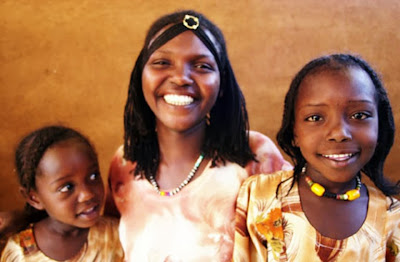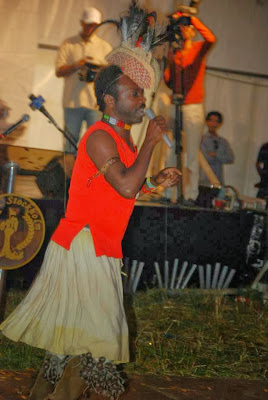| Dahab Faytinga, a former Eritrean freedom fighter turned musician, has been instrumental in promoting the Kunama language and culture to a global audience. Dahab, who is half Kunama on her father's side and Tigrinya on her mother's side, is the daughter of Faytinga; a celebrated war hero who was among the first Eritreans to fight for the country's independence. Faytinga in Kunama means the "fighting gun". |
Kunama People of Eritrea
he Kunama (koo-NAH-mah), who were historically known known as the "Baza" and "Bazen" by their neighbors, are a Nilo-Saharan ethnolinguistic group who inhabit the Gash-Seitit region of Eritrea. They make up around 2% of the Eritrean population, and are mostly sedentary farmers. Depending on the source, theTir name is thought to mean "those whom I call people"[1] or "natural".[2]
The term Kunama means natural. Among the Kunama if an individual misbehaves, often people would utter that the person is not behaving the "Kunama way" (i. e, the natural way). Similarly if you request drinking water from a woman who also has beer, the woman would ask you bia Kunama benube aifa? The meaning of this statement is "do you want natural water or beer?" In these two contexts the word Kunama is used to mean natural.[2]
Kunama history
Kunamas are believed to be one of the earliest inhabitants of Eritrea who originally migrated from the Southern Nile Valley of the Sudan (Nuba Mountains area). The earliest written mention of them comes from an unnamed Arab traveler, who upon visiting Aiwa (near Khartoum, Sudan) in in 872 BCE, noted the 'Cunama' (Kunama) and 'Baria' (Nara) groups were living on the borders of the Alodia (Alwa) Kingdom.[3] Another early glimpse of the Kunama comes from the 10th century Arab geographer Ibn Hawqal. He states they lived in the Barka valley, and fought with bows, poisoned arrows and spears, but did not use shields.[4] He also mentions the Kunama worship a God called Anna, and were ruled by a community of elders.[5]
With the arrival of Europeans in the region, the Kunama people faced frequent raids by their Western armed adversaries. Among the most violent raids ever recorded in the region was conducted by the Tigrayan warlord Ras Alula of Ethiopia, who in 1886, killed off two-thirds of the Kunama and Nara populations with British supplied weapons.[6]
Sidenote: So hated was Ras Alula by the Eritrean population, that upon the liberation of Eritrea, the people demanded the EPLF fighters to destroy a statue of Ras Alula in Dogali, whom the Ethiopian regime built during its brutal occupation of the country.[7]
Kunama culture
Compared to other ethnic groups in the country, the Kunama culture is considered egalitarian and liberal in nature.Women enjoy high social status and property rights, which the government often cites as a model for other Eritreans to follow.[1] Like their ancestors, Kunama members continue to follow village elders and elected assemblies. [8]Land in Kunama society is often farmed cooperatively and, after the work is finished, the village unites to celebrate with feasting and dancing, the latter of which they are famous for. Although small in number, Kunama music and dance forms are quite popular among Eritreans.
Most Kunama still adhere to their ancient religion centered on a creator god, Anna, and a complex of local spirits and ritual healers.[1] Currently, around 70% of Kunamas maintain their traditional faith, while a little over 30% have converted to Catholicism, Evangelicalism and Islam in the late 19th century. According to their beliefs, Anna created the sky and the Earth but is largely indifferent to human fate.[9] While their supreme deity is the most important figure in their religion, spirits seem to play a more prominent role among their daily activities and worship.
Kunama clan structure
The social structure of the Kunama is based on a division into six main clans, which are in turn divided into sub clans. The clans were based on lands, separating the Kunama into six groups, which again were divided into three to four sub-clans corresponding to localities. Clans and sub-clans are to this day exogamous and continue to use maternal lineage (the only ethnicity in Eritrea that does so). They include the Kara, Nataka, Serma, Jula, Sogona, Lakka, Akartakara, Alaka and Shila, among others [10]
Kunama language
The Kunama form their own distinct branch of the Nilo-Saharan language family. Both the Kunama and Nara, who are geographical neighbors, show similar results on correspondences with the ancient Sudanese Meroitic language: Nara a bit higher, Kunama lower. Linguistically, the languages are not close: Kunama is family H under Nilo-Saharan; Nara is sub-family E3 of East Sudanic. Professor Marvin Lionel Bender gives only 7% common basic lexicon between the two languages.
Random Kunama words and sentences translated into English
| # | Kunama | English | |
|---|---|---|---|
| 1) | Inkedino | Hello | |
| 2) | Inkankin nono? | Where are you from? | |
| 3) | Eritrea laganga | Eritrea is my country | |
| 4) | Eritrea dina nashama si anda gogonake | I am proud to be an Eritrean | |
| 5) | Kideya nano? | What is your name? | |
| 6) | Anda Kelake | You are beautiful | |
| 7) | Tagama kosimme | You are welcome | |
| 8) | Shonki Adadina Tori? | Can you please help me? | |
| 9) | Eritrea Gele dinise eldawde kinnake | Eritrea has nine main ethnic groups | |
| 10) | DInkalle Nokosso? | Who are you? | |
Source: Madote.com |
|||
 |
| Kunama mother with her children in Barentu, Eritrea |
 |
| Kunama girl hairstyle |
 |
| Famous Eritrean Kunama singer and former freedom fighter, Adengo Kuni |
______________________________________________________________
Notes:
[1] Historical Dictionary of Eritrea by Tom Killion, Dan Connell, p. 337
[2] Africa: rivista trimestrale di studi e documentazione, volume 56, p. 575
[3] Anthropological Linguistics, Volume 1 by Marvin L. Bender, p. 1
[4] The Ethiopian Borderlands by Richard Pankhurst, p. 28
[5] Islam in Ethiopia by J. Spencer Trimingham , p.51
[6] Blood, Land, and Sex: Legal and Political Pluralism in Eritrea by Roy Patemen, Lyda Favli , p. 36
[7] The Eritrean-Ethiopian war: retrospect and prospects by Medhane Tadesse, p.31
[8] Eritrea by Mussie Tesfagiorgis G. Ph.D, p. 176
[9] Ethiopia, Eritrea and Djibouti by Frances Linzee Gordon, p.284
[10]Environment, Society and the State in Western Eritrea by Alexander Naty, 2002

